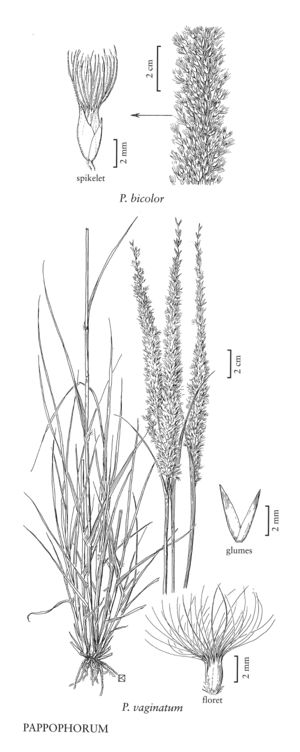Difference between revisions of "Pappophorum bicolor"
FNA>Volume Importer |
FNA>Volume Importer |
||
| Line 38: | Line 38: | ||
|publication year= | |publication year= | ||
|special status= | |special status= | ||
| − | |source xml=https://jpend@bitbucket.org/aafc-mbb/fna-data-curation.git/src/ | + | |source xml=https://jpend@bitbucket.org/aafc-mbb/fna-data-curation.git/src/f6b125a955440c0872999024f038d74684f65921/coarse_grained_fna_xml/V25/V25_933.xml |
|subfamily=Poaceae subfam. Chloridoideae | |subfamily=Poaceae subfam. Chloridoideae | ||
|tribe=Poaceae tribe Pappophoreae | |tribe=Poaceae tribe Pappophoreae | ||
Revision as of 19:25, 24 September 2019
Culms 30-80(100) cm. Sheaths mostly glabrous, apices with a tuft of hairs on either side; ligules about 1 mm; blades 10-20(30) cm long, 2-5 mm wide, flat to involute. Panicles 12-20 cm, narrow but usually with some slightly spreading branches, pink- or purple-tinged. Spikelets with the lower 2 or 3 florets bisexual, distal 1-2 florets sterile. Glumes 3-4 mm, thin, glabrous, apices acute or minutely notched and mucronate; lemmas somewhat firm, usually faintly 7-veined, with 11-15 awns; lowest lemma bodies 3-4 mm, midveins and margins pubescent from the base to about midlength, awns about 1.5 times as long as the lemma bodies; paleas subequal to the lemma bodies or slightly longer. Caryopses about 2 mm. 2n = 100.
Discussion
Pappophorum bicolor grows in open valleys, road right of ways, and grassy plains in Texas and northern Mexico. A report for Arizona (Mearns 1175) was apparently due to mixed labels. There have been no subsequent reports of the species from the state.
Selected References
None.
